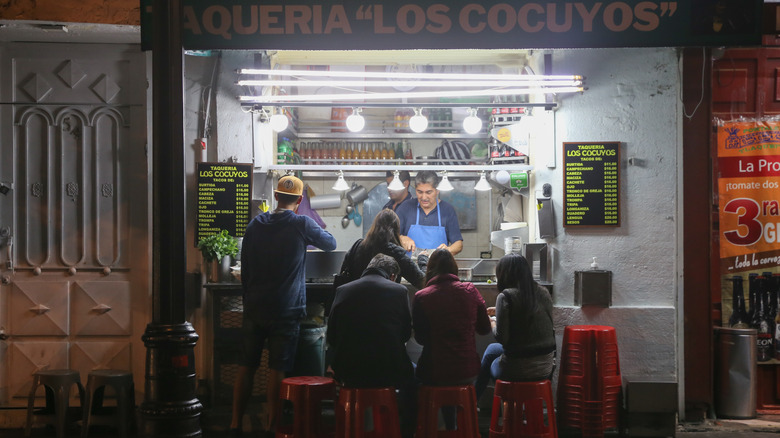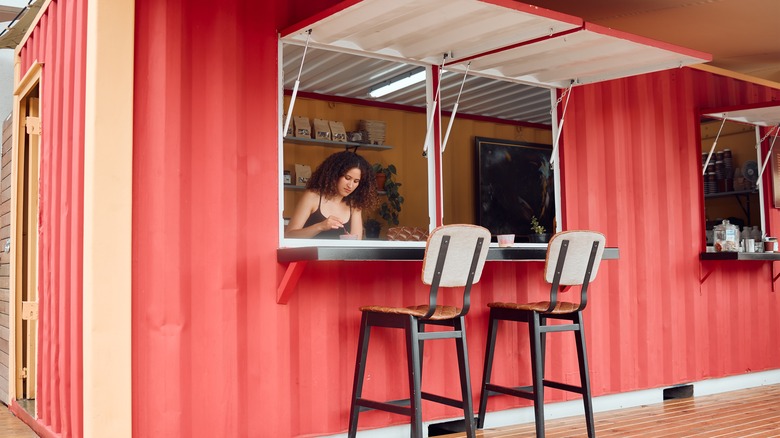Pop-Ups Just Might Be Providing A New Path For Marginalized Chefs
While indulging in a night out at an established eatery is fun, there's something special about going to a pop-up restaurant. A pop-up is a temporary experience, so it's an especially unique way to satisfy your hunger, and most of those hole-in-the-wall places offer truly some stellar food options. According to GQ, pop-ups give chefs, traditionally novices, the space to experiment with new dishes, let loose, and break into the vibrant culinary pool. Another draw of these temporary dining halls for customers is the mystery, with some pop-up locations only becoming known through word of mouth or a social media post, per GQ. So whether out of a magical food truck, home, temporary space, or other, you never know what to expect.
The concept of the pop-up became huge over the pandemic as traditional dining experiences areas became overwhelming for both employees and customers alike per the Los Angeles Times, but the concept has been popular for much longer than that. According to The New York Times, the idea started in the mid-1900s with independently-owned supper clubs where people served lunch out of their homes. While some people think modern-day pop-ups are spaces reserved exclusively for new chefs on the block, even established cooks are dipping their toes into the market. Aside from being a source of culinary inspiration, pop-ups just might be providing a new path for marginalized chefs.
What makes pop-ups stand out
A pop-up restaurant can take on many different forms, but a few characteristics make it a desirable choice for diners and chefs alike. This setup gives chefs a lot of freedom to try out new dishes since their location and menu are temporary rather than set in stone. According to The Manual, another appeal of the pop-up is the range of options it provides in terms of location. Chefs can use anything from food trucks to already existing restaurants to sell their cuisine, so the pressure is off to get the building or neighborhood just right.
A third reason pop-ups are so appealing to chefs is affordability, per The Manual. Because these pop-ups are temporary, most owners don't feel the need to shed unnecessary money on fancy equipment or decor. So if you prefer a more bare-bones approach, the pop-up route could be perfect. But perhaps one of the most appealing things about pop-ups for chefs is the wide scope of an opportunity it offers.
The opportunities that pop-ups can provide
Chefs that specialize in unique cuisine different than the mainstream have a space where their dishes can truly shine: right in the heart of a niche, underground community of chefs surrounded by their like-minded customers. This is a place where people can seek out something different than the traditional dining experience. Plus, rather than having to deal with traditional kitchen hierarchies, per Eater, chefs can take center stage from the get-go. According to Restaurant Opportunities Centers United surveying 133 restaurants, 81% of management positions were held by white people, and lower-ranking positions are increasingly held by people of color, via The Washington Post. For BIPOC that often struggle to break into the industry, this is a big deal.
While the representation pop-ups offer is a good thing, the disparity in permanent restaurants is still glaring with nearly 60% of chefs being white, per Statista. According to The New York Times, that is what is making more and more chefs prefer the pop-up path over anything. But despite the opportunities the pop-up can provide, perhaps the end-all-be-all should be a wider acceptance of culture and cuisine across the culinary world.


